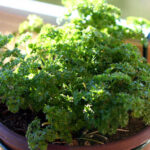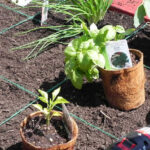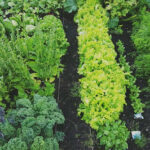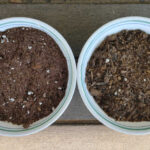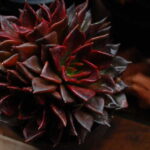Columnar trees add beautiful color and power to a landscape. They have their own spire-like beauty that provides a wonderful contrast against wide-spreading plants. These narrow trees look formal and crisp in appearance. Their slender shape often makes them appear well-pruned and neat, even though they may not have been pruned in a while. Instantly, they add a bit of beauty and grace to a landscape.
But what exactly are columnar trees? Is there science behind how they grow in such straight, column-like fashion? And most importantly, how do we maintain them so they look their best?
Let’s discuss everything you’ll need to know to maintain these lovely narrow trees properly!
What Is a Columnar Tree?
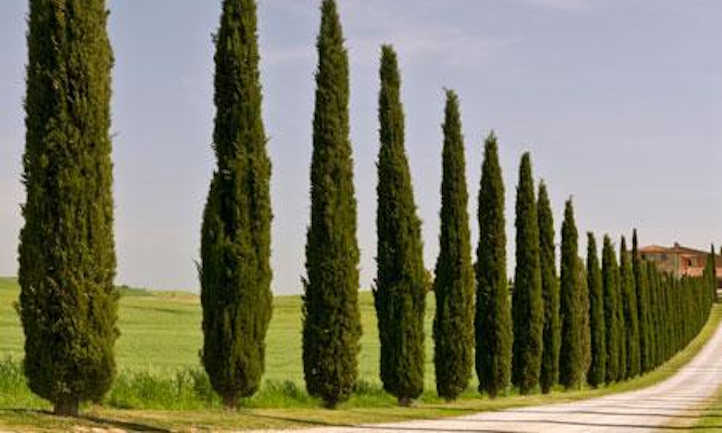
With columnar trees, you don’t need as much space. Many have fastigiate branches, which means they grow almost straight up rather than out from the tree, thus narrowing the size of the tree’s canopy. This form of growth allows the foliage at the branch tips to reach sunlight easily.
Columnar trees are extremely effective as a windbreak. Planting a row of them creates what amounts to a green wall that breaks up high wind and slows it as it rolls across your property. They’re also used with great effect as a privacy fence, since their foliage is often dense and thick.
In addition, columnar trees can be a dramatic garden feature. Adding these along the length of a long driveway makes for a stunning visual display, and a pair at either side of a porch can produce a dramatic, pillar-like effect.
How To Maintain Your Columnar Tree
Much of the process of pruning columnar trees is intended to enhance their upright growth habit. Since their branches do stay mostly upright, the goal is to reduce excess growth that is bending branches outward.
Examine any branch sections that are starting to curve outward. Is the branch itself thick enough to support the weight of its foliage? If not, look for a leaf node on the branch. These nodes provide a point from which new foliage can develop in the future. Clip just above that node, leaving the node in place and removing excess leaf weight. Be sure to use sterile clippers.
Whip-like slender growth that can’t support its greenery is often the most common target of pruning. But what of columnar fruit trees which require older wood to fruit on? Be careful with these, if only so you make sure to maintain some of that necessary older wood on your small garden trees.
If there are dead branches, those can and should be removed. Look to see whether any of the branch is still alive, and if so, try to keep the lower segment which is living. If not, remove it low on the tree to allow for other foliage to fill in space.
Most pruning of small trees for gardens will happen in the late fall or in the very early spring. Select a time in which fruit trees and some other species are dormant if possible. If there are broken or wind-damaged sections at other times of the year, you can remove those as needed to prevent damage to the rest of the tree.
Columnar Trees For Edible Gardeners
If you’re looking to grow fruit-bearing trees, there are columnar trees available for you! They take a bit more care, but it’s worth the effort.
Fruit trees, columnar or not, can be trained to an espalier type of growth. The upright “fan” shape used by many espalier growers is particularly suited for columnar trees.
While apples are a popular form of columnar tree, other fruits such as pear lend themselves to that shaping as well. Even some citrus trees like the key lime can be trained upwards to a columnar style. Most stone fruit or nut trees do not work as well in this style, and should be trained to other espalier patterns.
Please keep in mind that with most fruit-bearing columnar trees, you’ll need more than one to produce fruit. Neither of the two varieties we’re featuring here are self-fruitful. Get at least two to ensure you’ll have a good harvest.
Green Apple (Malus ‘North Pole’)
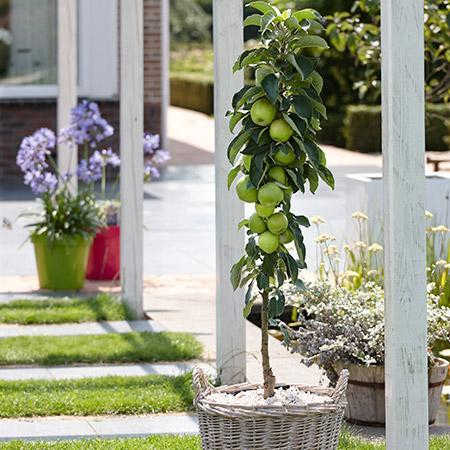
The ‘North Pole’ cultivar of columnar apple can grow up to a height of 8-12 feet tall and 2-3 feet wide, and is perfect for USDA hardiness zones 4-8. These are widely grown by home gardeners looking for an easy-care fruit tree. This deciduous tree also puts up a beautiful display of white flowers during spring.
The fruit is extremely juicy, crisp, and delicious and appears from late August through the entire month of September. Some grafted varieties can produce fruit even in their first year of growth!
Buy A Green Columnar Apple
Red Apple (Malus ‘Scarlet Sentinel’)

The ‘Scarlet Sentinel’ cultivar of apple is a deciduous, super-narrow, beautiful specimen. Strong branch development is key here, as it has a lower number than other species. But that strength also supports its eventual fruit!
Brilliantly white, lovely flowers form in the spring. These white blossoms give way to sweet red apples that ripen in September. Like the other apple, it averages 8-12’ tall and 2-3’ wide.
Buy A Red Columnar Apple
Weeping Persimmon (Diospyros virginiana JN5)

As claimed by one seller, this tree will likely outlive you! The average lifespan of a weeping persimmon is 75 years, and in that time it can reach a height of 25 to 30 feet with a spread of only 5-10 feet wide. Unlike other forms of columnar trees, the branch habit starts by pointing up then deliberately curves downward, creating the “weeping” form which provides its unique shape.
Thick, jade-colored leaves produce ivory-white flowers in the spring. As the seasons progress, the leaf color will develop some of the most lovely shades of autumnal brilliance you’ll see in a fruit tree. Brilliant red, yellow, and orange leaves will fall, leaving behind only plump and sweet orange fruit in late October and early November.
Buy A Weeping Persimmon
Compact Columnar Trees
If you’d like to grow evergreen trees for small gardens, then compact columnar trees are the ideal choice. They occupy less space than traditional landscape trees. Many columnar plants are perfect for container-growing as well. Consider putting a pair of small columnar trees on your balcony or in your smaller garden spaces!
Sky Pencil Holly (Ilex crenata ‘Sky Pencil’)

Sky Pencil Holly, native to Japan, is one of the most beautiful trees for small gardens. The name itself reveals its slender shape. It is extremely narrow and can grow 8-10 feet tall with only a 2-foot width, but it can also be kept shorter through pruning and shaping.
Evergreen in zones 5-9, this lovely landscape tree is fairly low-maintenance. It seldom needs pruning unless you’re trying to keep it to a dwarf habit. It’s one of the smallest columnar trees you can find, but that in no way reduces its potent beauty.
Buy A Sky Pencil Holly
Slender Hinoki Cypress (Chamaecyparis obtusa)
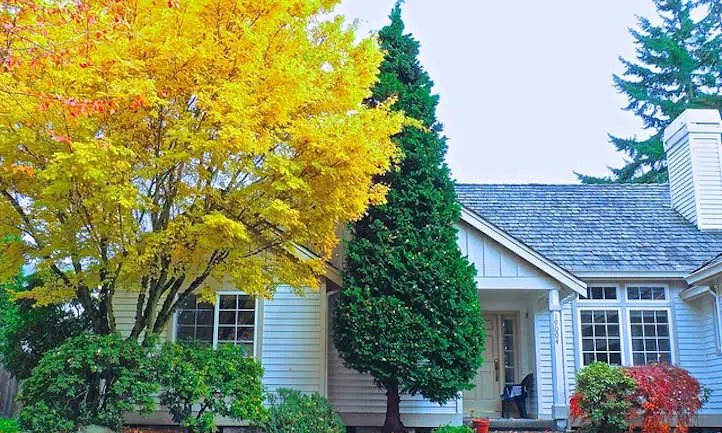
While technically not a true columnar tree, the slender Hinoki cypress grows in a fashion which is very similar. Soft, green foliage forms a slender column that grows almost from the soil all the way up to the tip of the tree. It averages 8-12 feet tall with a spread of 4-5 feet wide.
Somewhat bushy at its base, it has been popular over the years for large-format bonsai. But even when not formally trained into detailed shapes, your cypress plant will provide a lovely minimal-space, good-height addition to your landscape in zones 4-8.
Buy A Slender Hinoki Cypress
Skyrocket Juniper (Juniperus virginiana ‘Skyrocket’)
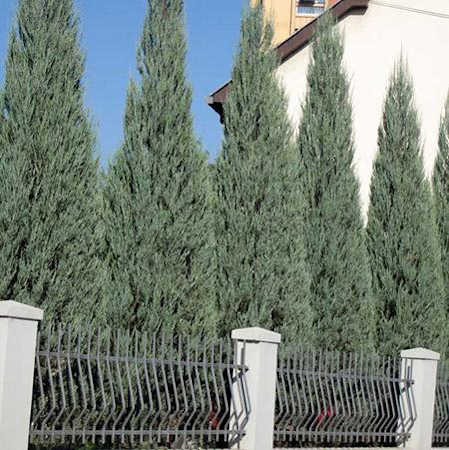
Hardy down to -20, the skyrocket juniper can grow comfortably in zones 4-9. Native to north America, it’s prized for its blue-green foliage and its ability to create a stunning privacy screen.
When mature, the skyrocket juniper easily hits heights of up to 15 feet with a 2-3 foot spread. Its evergreen foliage is similar to other juniper species, and has an added bonus. This species almost never requires pruning or detailed maintenance to keep it in shape.
Buy A Skyrocket Juniper
Spartan Juniper (Juniperus chinensis ‘Spartan’)
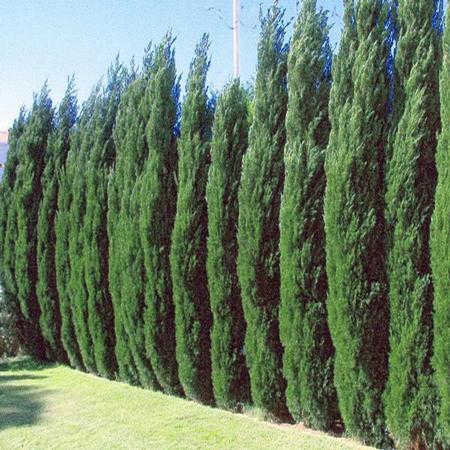
Tolerant to drought, a wide range of temperatures, and salt spray, the spartan juniper is one of the most popular upright and narrow junipers available today. Its deep green foliage provides plenty of color as a garden screen or windbreak. The dense-packed branch development on this plant effectively blocks anything from seeing through it.
In addition, junipers as a whole are pest resistant, which means you’re not going to be constantly spraying it down to keep it going. Hardy and easy to grow in either partial or full sunlight, this plant is best in zones 5-9. It easily hits 15-20 feet tall and 4-5 feet across in size.
Buy A Spartan Juniper
Large Landscape Columnar Trees
What if you want something that truly towers above the others we’ve suggested, yet maintains a narrow visual shape appropriate to columnar trees? We’ve got options in this category for you to plant, too. People with much larger space availability may find these more to their liking.
American Arborvitae (Thuja occidentalis)
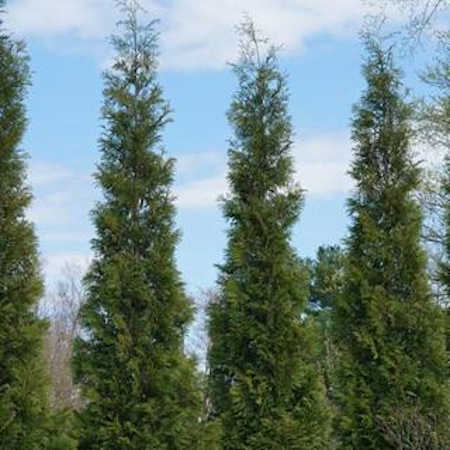
The rounded conical shape of the American arborvitae is perfect as a privacy fence for your garden. In addition, it’s a visual stunner, reaching heights of up to 30 feet with a maximum five-foot spread at its base. A row of these can make for a stunning peaked display!
The scaly leaves and fan-like branches are bedecked with a rich, red-brown bark. When it produces seed cones, they’re narrow and yellowish-green in color. It’s tolerant of most soil types, and is low-maintenance to keep going. Of the arborvitae species, I love the narrow tipped look of this one best.
Buy An American Arborvitae
Brodie Eastern Red Cedar (Juniperus virginiana ‘Brodie’)
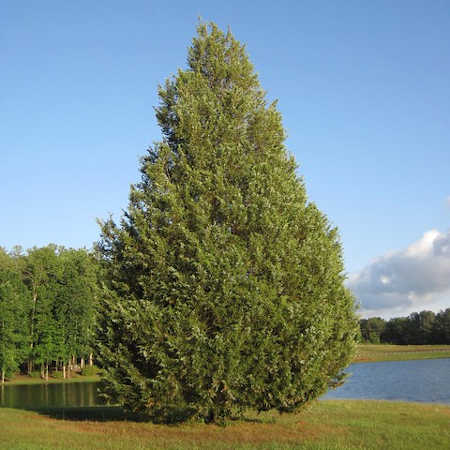
With one of the widest growing ranges of the columnar tree species we’re covering today, Brodie can be grown in zones 3-9 outdoors. It’s hardy down to -30 degrees Fahrenheit, yet can tolerate the warm and balmy climates of southern California as well. Best of all, this species can tolerate most levels of humidity from wet to incredibly dry with no problem.
The Brodie’s feather-like foliage is very self-maintaining. Little to no pruning is required to care for this tree. And if you want it to soar, it can; the Brodie can reach a maximum height of an astonishing 45 feet, with up to a 10-foot width. Kept pruned, it will stay at a more manageable height if you’d prefer.
Eastern red cedars provide lots of brilliant greenery in a densely-packed space. You’ll love the beauty that the Brodie can offer.
Buy A Brodie Eastern Red Cedar
Italian Cypress (Cupressus sempervirens)
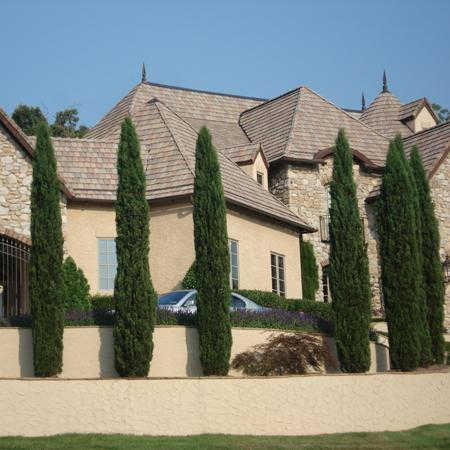
The Italian cypress is a true columnar variety, narrow in width and perfect for a myriad of uses. Their maximum width at full height is 5 feet, but if kept shorter they stay a narrow 2-3 feet wide at most. While they can achieve heights up to 40 feet if left to their own devices, they can be topped and maintained at a shorter height as well.
These are great for container or planter growing, and their lush green foliage thrives in full sun conditions. They perform the best in zones 7-11, and as a result are a common sight in residential developments throughout the southwestern US.
Buy An Italian Cypress
Lombardy Poplar (Populus nigra)
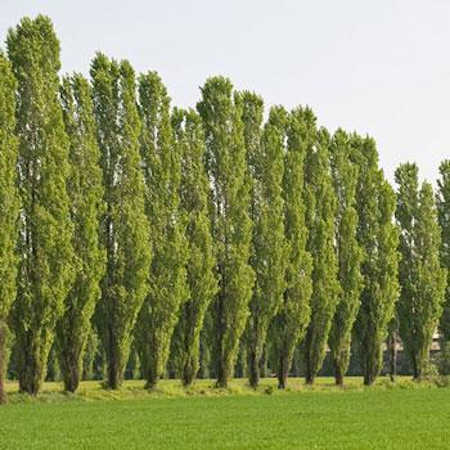
Have you ever driven past a large property that has a towering line of trees along one side? They might be lombardy poplar, particularly if they stand between 40-60 feet in height. These lovely poplar trees can form a large, solid barrier that makes them a prime candidate as windbreaks. They’re even used to prevent topsoil from blowing off farms!
Due to their height, they’re also astonishingly effective as shade trees. Planted eight feet apart, they intertwine to form a dense visual barrier as a living privacy screen. If you’re looking for something massive to create a living, woody boundary, this is a great choice. They’ll perform best in zones 3-9.
Buy A Lombardy Poplar
Colorado Blue Spruce (Picea pungens)
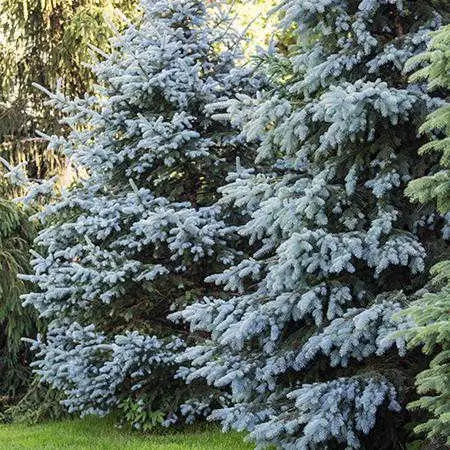
Last but certainly not least on our list is the Colorado blue spruce. This gorgeous coniferous evergreen has silvery blue-green needles and a conical growing habit. It’s the most adaptable to cold conditions of our recommended columnars, tolerating chill weather down to -40. Most often, it’s grown in zones 2-7.
Most people think of spruces in terms of a Christmas tree, and this one has that rounded conical habit. But due to its deep root system, it resists high winds like a champ, and it’s low-maintenance. And as it grows throughout the year, you’re treated to a lovely silvery-blue shade which stands out in landscaping. In the fall, you’ll also have 3” cones appearing in the upper crown of the tree.
While it grows to reach 50-75 feet in height in the wild, it can be maintained as a much smaller specimen, even as short as 10-12 feet. The top of the tree is narrow, but as it cascades downward, it widens to a pleasing base. All in all, it’s a lovely tree, and hey, when Christmas comes around, you can dapple it with white lights to enhance its holiday charm!
Buy A Colorado Blue Spruce

